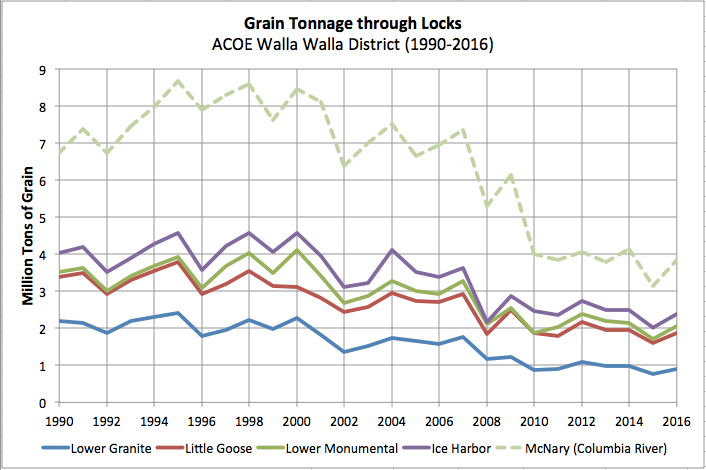forum
library
tutorial
contact

Study: In Breaching Snake River Dams,
Benefits Outweigh Costs
by Simone Del Rosario
Q13 Fox, July 29, 2019
|
the film forum library tutorial contact |

|
Study: In Breaching Snake River Dams,
by Simone Del Rosario
|
The amount of money the federal government spends subsidizing the lock system
far exceeds what the public gets from that usage.
 SEATTLE -- A new study is further dividing Washington state after concluding the benefits of breaching four dams on the lower Snake River outweigh the costs, both physically and to communities.
SEATTLE -- A new study is further dividing Washington state after concluding the benefits of breaching four dams on the lower Snake River outweigh the costs, both physically and to communities.
The future of the four dams in Central and Eastern Washington has been a hot topic for years and has only escalated as endangered southern resident orcas continue to struggle. People informed on the issue typically fall into two camps: Those who want to breach the dams to save threatened fish and orcas and those who insist the dams and its functions stay.
The Vulcan, Inc.-funded study tasked ECONorthwest with looking at the issue through an economic lens. Project director Adam Domanski said he hopes the report will add value to the conversation around the dams' future, acknowledging that opinions are largely preformed.
The four dams run along the Snake River between Tri Cities, Washington, and Lewiston, Idaho. Bonneville Power Administration uses the dams to produce hydropower, although they account for just a small percentage of power for the region.
The federal government subsidizing a lock system for the dams which allow for transportation via barge, where farmers can ship grain as far east as Idaho all the way to the ocean for export.
The first dam on the Snake River, Ice Harbor Lock and Dam, also provides irrigation benefits for several farmers nearby.
On the flip side, the dams impede threatened fish from reaching critical habitat. In addition, salmon researchers say a free-flowing river would give them more favorable conditions in the face of climate change, since damming the rivers has a warming effect.
Some of the endangered southern resident orcas' top-priority Chinook salmon stocks come from the Snake River.
After looking at all of the dams' uses, ECONorthwest concluded that not only do the benefits of breaching exceed the costs, but that, "society would likely be better off without the dams."
The study showed that when it comes to energy, there is a cost to the dams going off the grid. Some estimates have energy bills going up around $1 to $2 a month. Carbon emissions could also go up if there is not clean-energy replacement.
The most damning part of the study is its look at barging on the river. The report shows the amount of money the federal government spends subsidizing the lock system far exceeds what the public gets from that usage.
It also pointed to moderate costs for adjusting irrigation systems for farmers.
In a joint statement, Reps. Dan Newhouse (R-4th District) and Cathy McMorris Rodgers (R-5th District) said, "This privately-funded study is a slap in the face of our state's agricultural economy. It is another example of Seattle-based interests failing to understand our way of life in Central and Eastern Washington."
Rep. Jaime Herrera Beutler (R-3rd District) responded to a request from Q13 News, saying the study is pushing an anti-dam agenda.
Domanski noted that the agricultural community does stand to lose but said the economic argument is not behind them.
"I would hope that as people talk about policy solutions, that they can pragmatically address those losses and not make it the center of the debate, because it's not the biggest issue at play," Domanski said.
ECONorthwest used what's called "non-use value" or "existence value" to calculate the benefit side of breaching, which put the net-benefit at more than $8 billion between 2025 to 2045.
"It's the value that someone might have for the protection or preservation of environmental good without their direct use of it," Domanski said. "People in the region are willing to take money out of their own pocket and pay for this environmental service."
The non-use value is what will likely make ECONorthwest's figures most different from the upcoming environmental impact statement being drafted by the federal government. In the past, the U.S. Army Corps of Engineers has not used this concept of existence value in its final cost-benefit analysis of the dams.
When asked, a spokesman for USACE said they have not read the ECONorthwest study as they focus on their own court-ordered study, which looks at the entire Columbia River System Operations. A draft of that environmental impact statement is expected to come out in February 2020. One of the alternatives being evaluated contains breaching the lower Snake River dams.
Washington Gov. Jay Inslee's office said they do not have a position on the ECONorthwest study. His office is working on an orca task force-recommended study on dam breaching to ensure state voices are heard in the ongoing federal process.
According to his office, the forum, funded by state lawmakers to the tune of $750,000, will provide the state with an analysis of the positive and negative aspects of breaching the lower Snake River dams and help inform the state's position on the federal study.
The study will not recommend whether the dams should be breached, develop potential mitigation options or address costs.
learn more on topics covered in the film
see the video
read the script
learn the songs
discussion forum
